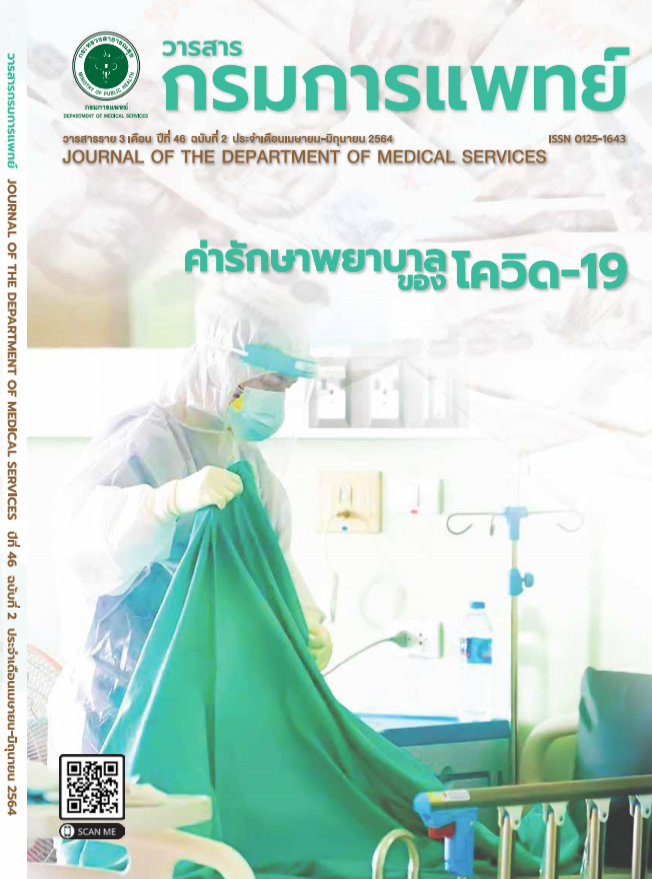ผลของโปรแกรมส่งเสริมพัฒนาการด้วยคู่มือประเมินและส่งเสริมพัฒนาการเด็กกลุ่มเสี่ยง (DAIM) ร่วมกับทฤษฎีการเรียนรู้สำหรับผู้ใหญ่
คำสำคัญ:
ทารกเกิดก่อนกำหนด, โปรแกรมส่งเสริมพัฒนาการด้วยคู่มือประเมินและส่งเสริมพัฒนาการเด็กกลุ่มเสี่ยง (DAIM), ทฤษฎีการเรียนรู้สำหรับผู้ใหญ, ผู้ดูแลบทคัดย่อ
ภูมิหลัง: เด็กกลุ่มเสี่ยง คือเด็กที่มีภาวะขาดออกซิเจนขณะ คลอด และ/หรือมีน้ำหนักแรกเกิดน้อยกว่า 2,500 กรัม เป็นปัจจัย หลักที่ทำให้เด็กมีภาวะพัฒนาการล่าช้า ผู้ดูแลจึงมีความสาคัญใน การเฝ้าระวังและส่งเสริมพัฒนาการทารกกลุ่มนี้ วัตถุประสงค์: เพื่อศึกษาผลของโปรแกรมส่งเสริมพัฒนาการด้วยคู่มือประเมิน และส่งเสริมพัฒนาการเด็กกลุ่มเสี่ยง (DAIM) วิธีการ: การวิจัย กึ่งทดลอง 2 กลุ่มวัดก่อน-หลัง กลุ่มตัวอย่างเป็นผู้ดูแลหลักและ ทารกเกิดก่อนกาหนด รับการรักษาในสถาบันสุขภาพเด็กแห่งชาติ มหาราชินี 30 ราย คัดเลือกแบบเฉพาะเจาะจง แบ่งเป็นกลุ่มควบคุม และกลุ่มทดลองกลุ่มละ 15 ราย กลุ่มควบคุมได้รับการส่งเสริม พัฒนาการตามปกติ กลุ่มทดลองได้รับโปรแกรมส่งเสริมพัฒนาการ ด้วยคู่มือประเมินและส่งเสริมพัฒนาการเด็กกลุ่มเสี่ยง (DAIM) ร่วมกับทฤษฎีการเรียนรู้สำหรับผู้ใหญ่ เครื่องมือ 1) แบบสอบถาม ข้อมูลทั่วไป 2) โปรแกรมส่งเสริมพัฒนาการด้วยคู่มือประเมินและ ส่งเสริมพัฒนาการเด็กกลุ่มเสี่ยง (DAIM) 3) แบบประเมินความ รู้ 4) แบบสอบถามพฤติกรรม 5) แบบสัมภาษณ์และติดตามการส่ง เสริมพัฒนาการทางโทรศัพท์ เวลาศึกษา 8 สัปดาห์ สถิติใช้คือร้อยละ ค่าเฉลี่ย The McNemar Test, The Mann–Witney U Test และThe Wilcoxon Matched Pairs Signed–Ranks Test ผล: หลังการศึกษาทารกกลุ่มทดลองมีพัฒนาการสมวัย อย่างมีนัยสำคัญ ทางสถิติที่ระดับ .05 คะแนนความรู้ผู้ดูแลกลุ่มทดลอง สูงกว่ากลุ่ม ควบคุมอย่างมีนัยสำคัญทางสถิติที่ระดับ .05 และคะแนนพฤติกรรม กลุ่มทดลองกับกลุ่มควบคุมไม่แตกต่างกัน สรุป: โปรแกรมส่งเสริมพัฒนาการด้วยคู่มือประเมินและส่งเสริมพัฒนาการเด็กกลุ่มเสี่ยง (DAIM) ร่วมกับทฤษฎีการเรียนรู้สาหรับผู้ใหญ่ เป็นเครื่องมือที่ช่วย ให้พยาบาล มีแนวทางปฏิบัติและนำไปประยุกต์ใช้ในการเฝ้าระวัง และส่งเสริมพัฒนาการเด็กกลุ่มเสี่ยง
เอกสารอ้างอิง
Office of Inspection and Evaluation Office of the Permanent Secretary.Guidelines for project implementation Promoting child development in honor of HRH Princess Maha Chakri Sirindhorn The Royal Crown Prince Opportunity to celebrate the 5th Cycle, 2 April 2015, 2016, Nonthaburi.
Rajanagarindra Institute of Child Development, Ministry of Public Health,Department of Mental Health. Thai development skills inventory for children from birth to five years; 2010.
Feldman R, Eidelman AI. Intervention program for premature infants. How and do they affect development? Clinics in Perinatology; 1998.
Knowles MS, Swanson RA, Holton EF. The adult learner: the definitive classic in adult education and human resource development 7th ed. London: Elsevier; 2011.
Chawaphanth S. Surveillance and Promotion of Early Childhood Using Andragogy. J Nurs Sci 2018; 36: 4-17.
Busaba Authavee, Bampen Phongphetdit. The use of the DSPM to promote child development, 5th Regional Health Promotion Center, Ratchaburi; 2017
Anita J. Hughes. Moter Development Interventions for Preterm Infant: A Systematic Review and Meta-analysis; 2016.
Brooks-Gunn J, Liaw FR, Klebanov PK. Effects of early intervention on cognitive function of low birth weight preterm infant. J Pediatr 1992; 120:350-9.
Thawittha L. Preterm infant development promoting behaviors among primary caregivers and related factors. Nursing Journal; 2016.
Paiprasert S. Factors affecting development of children aged 0-3 years old in Health Inspection Region 18. Journal of Pediatrics; 2012.
Sakolwasan U. Knowledge, Self-efficacy, and Behaviors in Promoting Preterm Infant Development Among Primary Caregivers. Chiang Mai University; 2007.
Sutalangka M. Maternal Care and Related Factors in Developmental Care of Preterm Infants. Nursing Journal; 2017.
ดาวน์โหลด
เผยแพร่แล้ว
รูปแบบการอ้างอิง
ฉบับ
ประเภทบทความ
สัญญาอนุญาต
ลิขสิทธิ์ (c) 2021 กรมการแพทย์ กระทรวงสาธารณสุข

อนุญาตภายใต้เงื่อนไข Creative Commons Attribution-NonCommercial-NoDerivatives 4.0 International License.
บทความที่ได้รับการตีพิมพ์เป็นลิขสิทธิ์ของกรมการแพทย์ กระทรวงสาธารณสุข
ข้อความและข้อคิดเห็นต่างๆ เป็นของผู้เขียนบทความ ไม่ใช่ความเห็นของกองบรรณาธิการหรือของวารสารกรมการแพทย์



